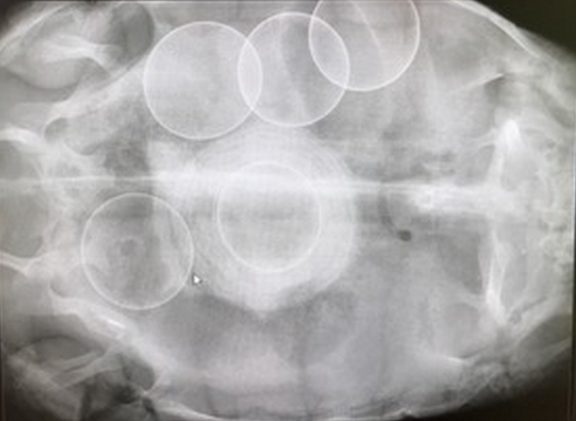A cooter in the laying container along with its clutch of eggs. Note the grid the turtle is standing on. The holes are big enough for the eggs to fall through to the moistened surface below. The grid is also high enough so the turtles sharp claws cannot damage the eggs.

The prostaglandin induction technique (PIT) to induce oviposition in turtles
Learn how to do it with our easy to follow guide and instructional videos found below.
Introduction
In a captive situation it can be very difficult to get turtles to lay their eggs naturally. The female will often choose to retain the eggs if the soil required to dig her nest is not just right. To be “just right” the soil has to be the correct consistency, temperature, and have the right odor and moisture levels. Sometimes turtles will chose to only oviposit in the shade, full sun or under structures like plants or fallen wood, so the best conditions can be difficult to provide in captivity.

The end result of being egg bound (dystocia). This turtle died a few days later (photo by Dr Walter Sachsse)
If the captive environment is not just right the female will retain the clutch of eggs. This is called being egg-bound or suffering from egg-retention. For most species eggs that are retained will develop thickened shells and will not be viable. In that case the best result you can hope for is that the eggs will be excreted (or dropped) in the water or on the land. The worst outcome is when the eggs are retained for a prolonged period causing the next clutch of eggs to be retained as well. This can lead to dilation of the oviduct which may eventually kill the animal.

The two drugs we use most often: Lutalyse, a brand name for prostaglandin F2 alpha and Sedivet, the brand name for romifidine, an alpha-agonist. We have experimented with a variety of other congeners of prostaglandin F2 alpha and they were not as effective.
We are still developing this web site. For key information there is a PDF instructional that will tell you the basics. You can find this at the bottom of this page. There you can learn what drugs and dosages to give to some specific species of turtles. We update these pages once or twice a year as we develop new data. If you go to the section labeled “Primary data” you can see the mechanics of how we did our research and the details of the various study results that led to the recommendations in the PDF.
There is also a collection of five videos that give more detail on how to induce oviposition. You can access those immediately below. In addition, there is a one minute video showing a turtle laying its eggs after being induced; this is also available immediately below. For people that cannot access You Tube there are copies of all six videos (labeled “non-You Tube version”) after the PDF at the very bottom of the page. We have also added all six of these videos with Chinese subtitles. The translations have been done by Shawn Ho, a native Chinese who has a remarkable command of American style English.
Click here to find a short biography explaining how we have done our work over the past forty years and a “thank you” to the people that have helped us out.
Under the heading “2007 article” we have provided the results of our initial work along with the references that helped us develop our methods. At the end of the section labeled “Primary data” there is an additional reference section that relates to our later work. We also want feedback from you so we can find out how our methods worked with species we don’t have to access to. You can provide that feedback on the contact us page. We will incorporate your comments into our plans for further research and publish them on the web site.
Part 1
Part 2
Since this video was made the dose of Sedivet has been updated. See the PDF on this website HERE.
Part 3
Part 4
Part 5
One Minute Video Of The Egg Laying Process
Instructional Videos (Non Youtube version)
Part 1
Part 2
Part 3
Part 4
Part 5
One Minute Video Of The Egg Laying Process
Instructional Videos (Non Youtube version) (CHINESE TRANSLATION)
Part 1

Part 2

Part 3

Part 4

Part 5

One Minute Video Of The Egg Laying Process


